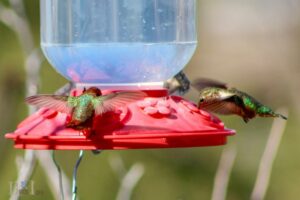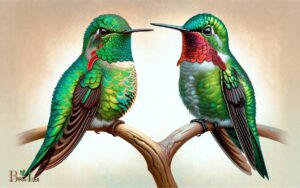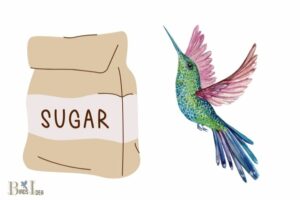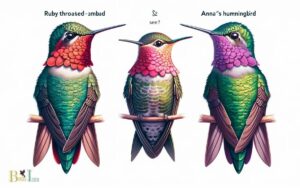Ruby Throated Hummingbird Favorite Flowers: Bee Balm!
The Ruby-throated Hummingbird’s favorite flowers typically include brightly colored, tubular-shaped blooms like the trumpet creeper, bee balm, cardinal flower, and jewelweed.
These flowers not only provide the high-energy nectar that hummingbirds need for sustenance but also have structures that are well-adapted to their feeding habits.
Ruby-throated Hummingbirds, known scientifically as Archilochus colubris, are attracted to flowers that not only provide them with the necessary nectar but also align with their physical characteristics and feeding behavior.
Preferred flowers tend to share several attributes:
Example of plants frequented by Ruby-throated Hummingbirds:
Additionally, many of these plants are native to the regions where Ruby-throated Hummingbirds are found, making them not only attractive food sources but also important components of the local ecosystem.
With their iridescent emerald feathers and a preference for nectar-rich blooms, Ruby-throated Hummingbirds play a crucial role in the pollination of many North American wildflowers.
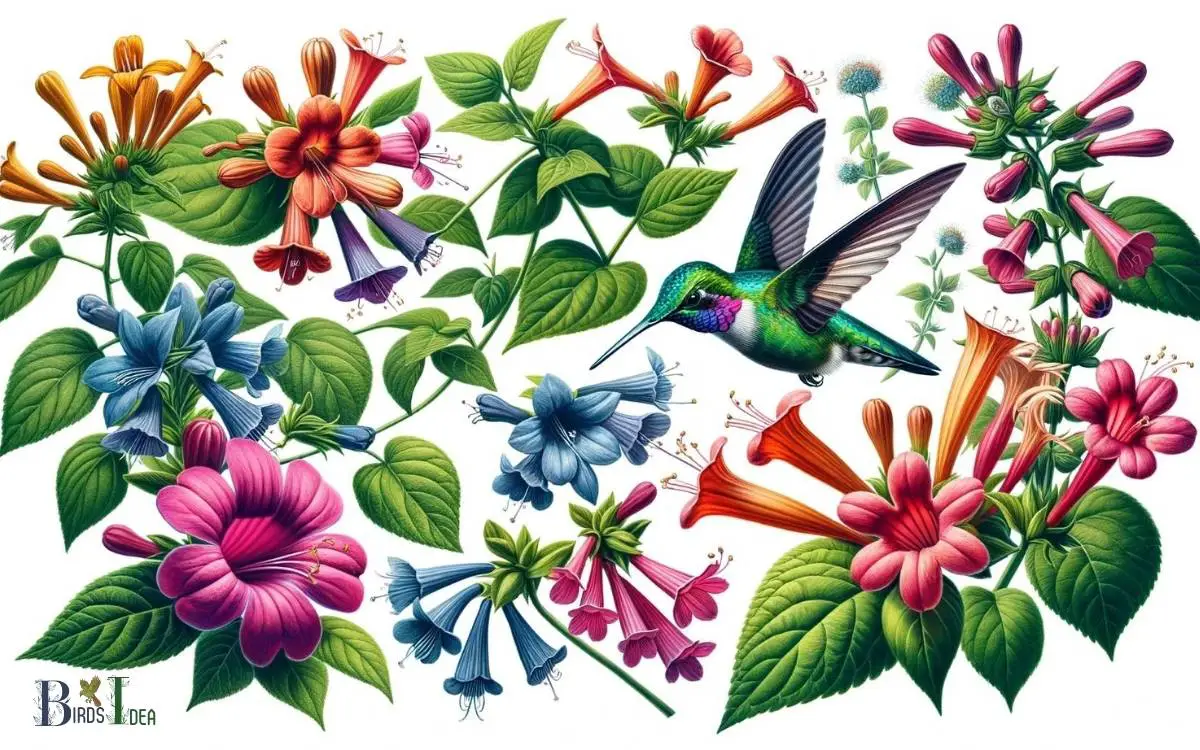
Key Takeaway
Characteristics of Ruby-Throated Hummingbirds
The characteristics of the Ruby-Throated Hummingbird make it a fascinating subject for ornithologists and bird enthusiasts alike.
These tiny birds, weighing only about 3 grams, are known for their vibrant, iridescent green feathers on their back and a brilliant ruby-red throat patch on the males.
They have a remarkable ability to hover in mid-air, thanks to their rapid wingbeats, which can reach up to 53 times per second.
Their long, needle-like bill and specialized tongue allow them to extract nectar from flowers with impressive precision.
Ruby-throated hummingbirds are also known for their migratory behavior, traveling up to 3,000 miles from their breeding grounds in North America to their wintering grounds in Central America.
Their unique physical and behavioral traits make them a captivating subject for study.
These characteristics also play a significant role in their choice of flowers for nectar, such as the red bee balm, a ruby-throat favorite.
Red Bee Balm: A Ruby-Throat Favorite
Red bee balm, a favorite flower of the ruby-throated hummingbird, is frequently sought out due to its rich nectar content and vibrant red color. This perennial plant, also known as Monarda didyma, belongs to the mint family and is native to North America.
The tubular shape of the red bee balm’s flowers perfectly complements the long, slender bill of the hummingbird, allowing for easy access to the nectar with their specialized beaks. The bright red color acts as a visual attractant, drawing the attention of these tiny birds.
When in bloom, the red bee balm provides a bountiful supply of nectar, making it an essential food source for the ruby-throated hummingbird during their migration and breeding seasons. This makes it a vital component of hummingbird-friendly gardens.
Delicate Trumpet-Shaped Coral Honeysuckle
An elegant addition to the hummingbird-friendly garden is the delicate trumpet-shaped coral honeysuckle.
This native perennial vine, Lonicera sempervirens, produces clusters of tubular, coral-red flowers that are perfectly shaped for the long, slender beak of the ruby-throated hummingbird.
The nectar-rich blooms of the coral honeysuckle attract these tiny birds, providing them with a vital food source during their migration. This vigorous, twining vine is easy to grow and thrives in various soil types and light conditions.
Its lush green foliage and vibrant flowers add beauty to arbors, fences, and trellises, making it a versatile and attractive choice for gardeners. With its ability to support and nourish these delightful birds, the coral honeysuckle is a must-have for any hummingbird garden.
Bright and Alluring Cardinal Flower
A vibrant addition to the hummingbird garden is the bright and alluring Cardinal Flower, known for its striking red blossoms that capture the attention of the ruby-throated hummingbird.
This native perennial plant, scientifically named Lobelia cardinalis, offers not only stunning visual appeal but also serves as a vital nectar source for hummingbirds.
Here are four key points to consider:
- Attractive Blossoms: The Cardinal Flower produces tall spikes adorned with tubular, cardinal-red flowers, making it an eye-catching addition to any garden.
- Hummingbird Magnet: The bright red color and tubular shape of the blossoms are specifically adapted to attract hummingbirds, making it a favorite nectar source for these agile birds.
- Growth Conditions: Cardinal Flowers thrive in moist, partially shaded areas, making them an ideal addition to gardens with diverse microclimates.
- Conservation Value: Planting Cardinal Flowers can contribute to the conservation of native plant species and the preservation of hummingbird habitats.
Sweet Nectar of Jewelweed
The sweet nectar of jewelweed serves as a vital energy source for the ruby-throated hummingbird during its migratory journey.
This delicate, trumpet-shaped flower produces a copious amount of nectar, which is rich in sucrose, glucose, and fructose, providing the necessary fuel for the hummingbird’s demanding flight.
The unique structure of the jewelweed flower allows for easy access to the nectar, catering to the hummingbird’s specialized long, slender bill and extendable, tube-like tongue.
The abundance of nectar in jewelweed flowers makes them a favored feeding spot for these tiny, agile birds.
As the hummingbirds flit from flower to flower, their swift movements contribute to the pollination of jewelweed, further emphasizing the symbiotic relationship between the bird and the plant.
This mutually beneficial interaction highlights the significance of jewelweed as a vital component of the ruby-throated hummingbird’s migratory journey.
Attracting Ruby-Throated Hummingbirds
Attracting Ruby-throated hummingbirds requires planting flowers rich in nectar, which serve as a vital energy source for the birds during their migratory journey.
To effectively attract these delightful birds to your garden, consider the following:
- Plant nectar-rich flowers: Choose trumpet-shaped flowers such as bee balm, cardinal flower, and trumpet vine, which are particularly appealing to hummingbirds due to their abundant nectar.
- Provide a variety of colors: Hummingbirds are attracted to a range of vibrant colors, so include red, orange, and pink flowers in your garden to catch their attention.
- Create a welcoming environment: Place feeders and flowers in open areas where hummingbirds can easily spot them and have space to maneuver.
- Maintain a water source: Consider adding a small water feature, such as a fountain or shallow birdbath, to provide hummingbirds with a place to drink and bathe.
Conclusion
The Ruby-Throated Hummingbird displays a strong preference for certain flowers, such as the red bee balm, coral honeysuckle, cardinal flower, and jewelweed.
These flowers provide the necessary nectar for the hummingbird’s survival, and their bright colors and unique shapes attract the hummingbird’s attention.
By planting these flowers in your garden, you can create a welcoming and nurturing environment for these beautiful and delicate creatures.

